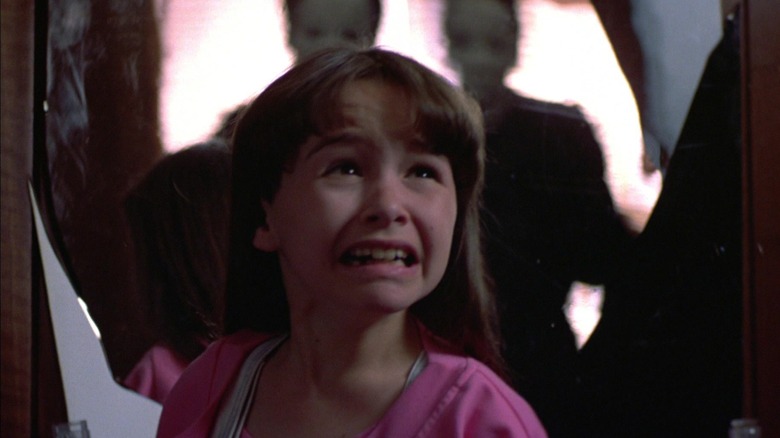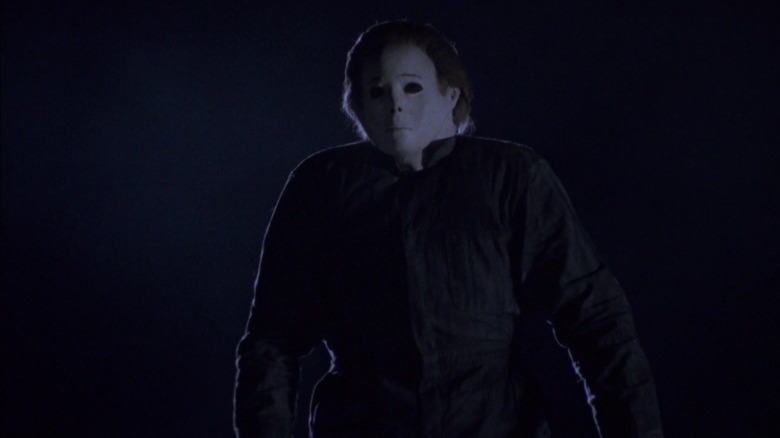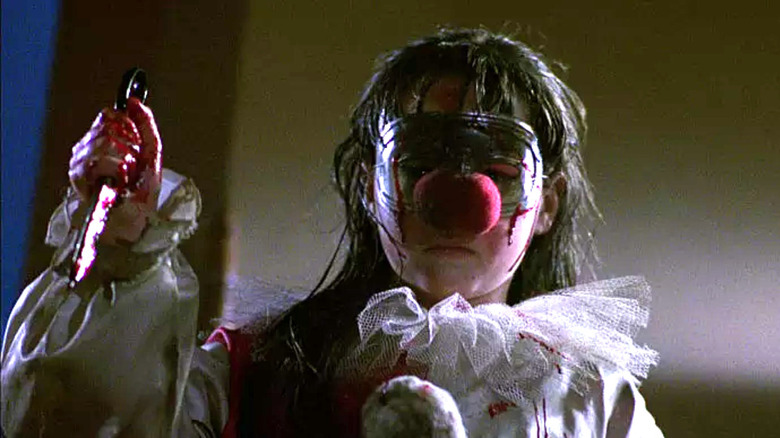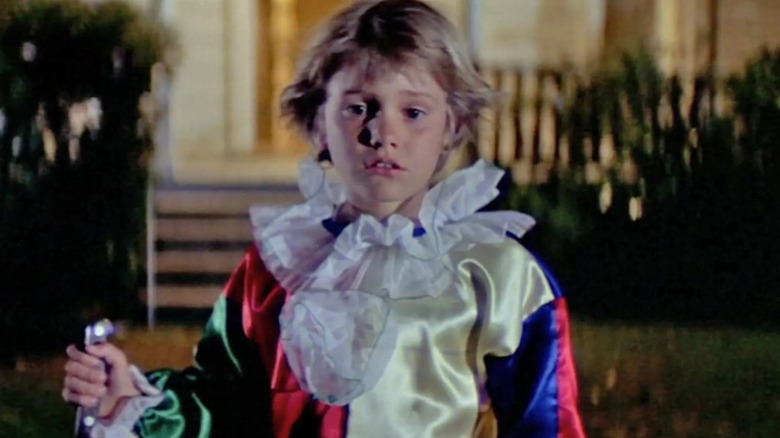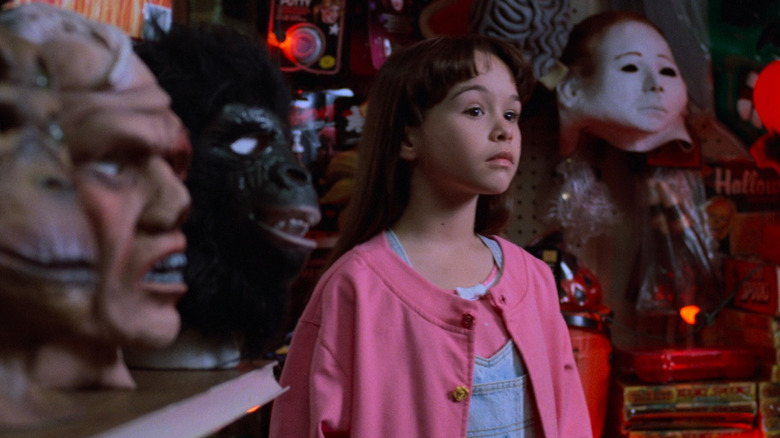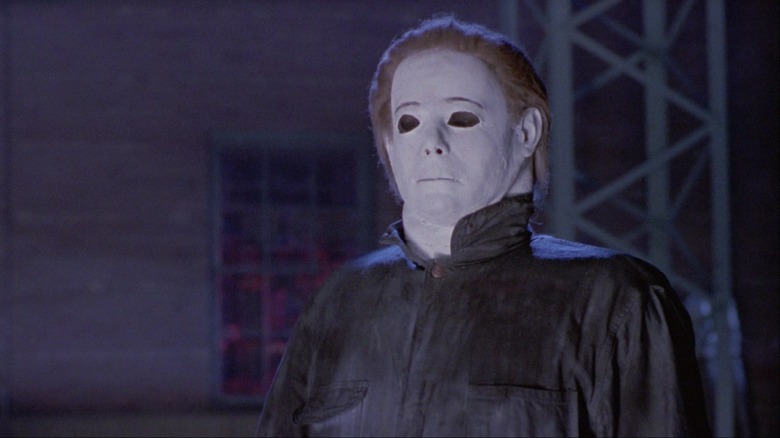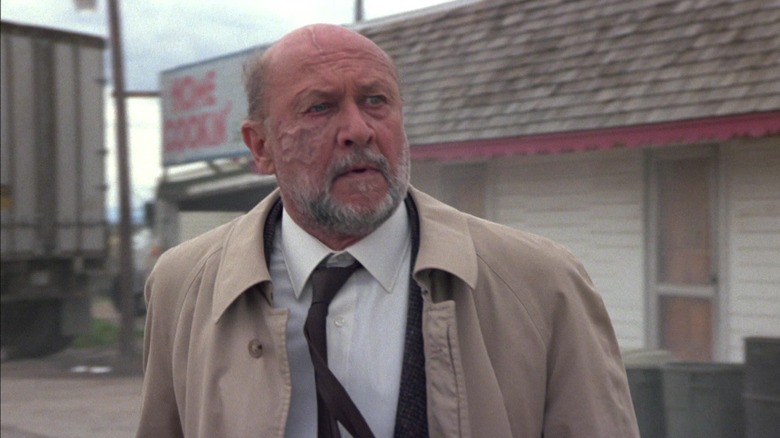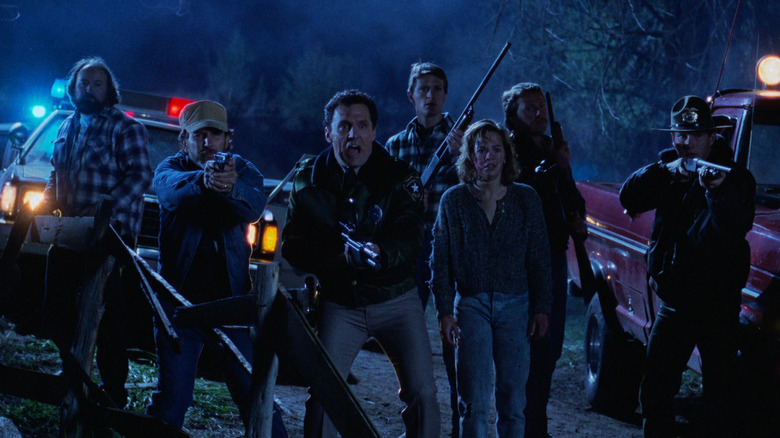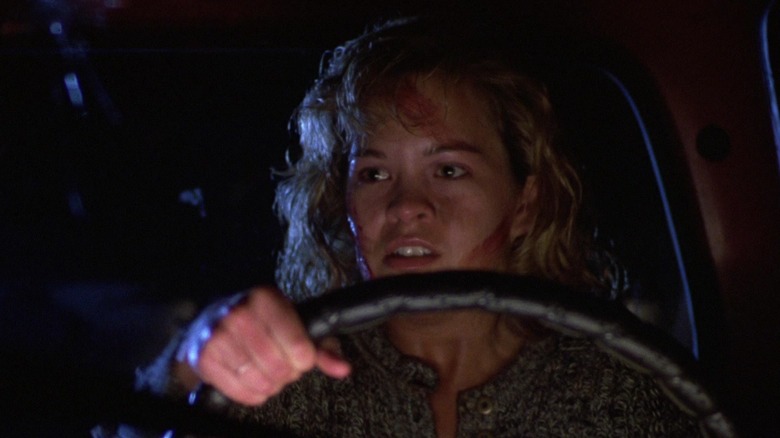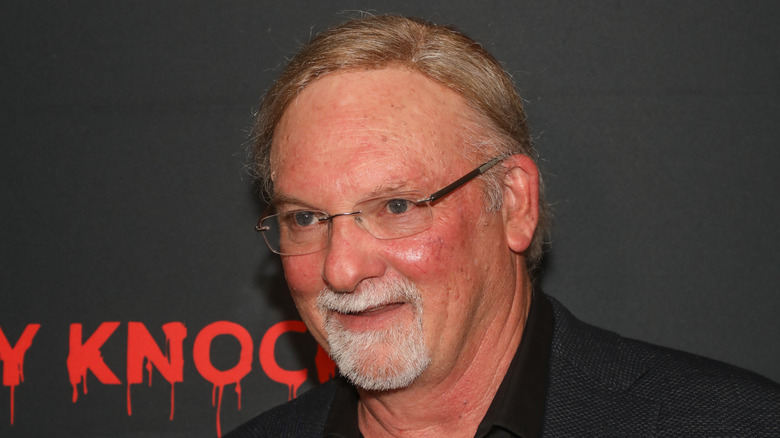The Ending Of Halloween 4: The Return Of Michael Myers Explained
If not for its absolutely bonkers ending, there might not be much to remember about "Halloween 4: The Return of Michael Myers." As the title suggests, this was the return of the iconic bogeyman of the "Halloween" franchise after "Halloween III: Season of the Witch" attempted to turn the series into an anthology sans Michael Myers. This failed to bring in a crowd as large as the previous two entries, so it was back to the drawing board for the 1988 sequel. "Halloween 4" was a return to form in so many ways that its dark and shocking ending might be the only thing it has in common with "Season of the Witch," a movie that also has a surprising jolt of last-minute terror.
If you watch closely, you will see there are clues that — should you interpret them a certain way — set up the turn at the movie's end. If the ending of "Halloween 4" left you baffled, we're here to explain what happened and how it set up a trilogy of "Halloween" movies in the 1980s and '90s.
What you need to remember about the plot of Halloween 4
All things considered, "Halloween 4" is a pretty straightforward "Halloween" movie, especially if you've seen many of the other entries in the series. It begins with Michael Myers (George P. Wilbur) escaping from prison while being transferred to another facility. Rule No. 1 of "Halloween" — never try to move Michael. If you've had him contained for a decade it ain't broke and you don't need to fix it.
Following up on his motivations from Rick Rosenthal's "Halloween II," Michael goes after his family. While Laurie Strode (Jamie Lee Curtis) has disappeared, her daughter, Jamie Lloyd (Danielle Harris), lives with a foster family in Haddonfield. Oh, did we mention that it happens to be October 31st? In the meantime, Dr. Loomis (Donald Pleasence) discovers that Michael has broken free and tracks him down.
Jamie is terrorized by visions of Michael. Her foster sister, Rachel (Ellie Cornell), tries to console her by taking her to buy a Halloween costume. Jamie finds a creepy clown costume at the costume shop and sees Michael. When Rachel takes her trick-or-treating on Halloween night, it turns into a typical Haddonfield nightmare as Michael stalks Jamie and Rachel, killing ancillary characters along the way. The town mob eventually corners Michael, and Jamie approaches him, touching his hand before he falls into a collapsing mine. Jamie, Rachel, and Dr. Loomis go back home to a happy ending. Or so it seems.
What happened at the end of Halloween 4?
After our three heroes make it back to the Lloyd family home, Loomis proclaims that Michael is finally dead and that evil has at last been conquered. If that's not enough of a hint that maybe things won't go as planned, the creepy POV shots might clue anyone who has seen the original "Halloween" into what's about to happen. In these POV shots, we get a first-person view of someone wandering the Lloyd home. And then, a hand reaches for a scissors. In intercut shots, we see Jamie's foster mother, Darlene (Karen Alston), draw a bath.
In a final, now-masked, POV shot, the camera moves into the bathroom, and we see Darlene's horrified face before a hard cut and a scream. As Loomis and the others rush up the stairs, they see the film's shocking final image — Jamie dressed up in her clown costume holding the bloody scissors above her head.
Loomis begins to scream and break down, eventually pulling his gun and raising it up toward Jaime. Held back by a police officer, Loomis convulses. Jaime stands there mute and raises the murder weapon once more before the credits start to roll.
The movie's final images are a callback to the roots of the franchise
The epilogue of "Halloween 4" is a mirror image of sorts to the prologue of John Carpenter's 1978 original "Halloween." In the iconic opening of the first film in the franchise, we get a POV walkthrough of a typical suburban house that ends in murder. Once the killer goes outside, it is revealed that he is Michael Myers as a child — dressed in a clown costume, masked and brandishing a knife.
These POV camera shots are recreated by director Dwight H. Little in this final sequence with Jaime. Both sequences feature a final shot where the character finally puts on the mask before doing the killing — a defining characteristic of Michael Myers' methodology. The character has killed without a mask, sure, but if he can get his hands on one, finding a mask always seems to be the killer's top priority.
The clown costume Jamie wears evokes what Michael was wearing when he killed his sister in "Halloween," even if they aren't exact replicas. Afterward, Jamie stands there shocked and covered in blood, just as Michael stood shocked and silent after walking out of the house after his sister's killing. These images mirror the original and reinforce the thematic reasons Michael Myers is immortal. He is the indestructible embodiment of pure evil, and that evil has now seemingly leaped to Jamie.
Why did Jamie kill her foster mother?
This ending scene is pretty disturbing because of how quickly it turns the movie on its head. Only minutes ago, Jamie was cowering in terror and crying, and now she is a completely changed person, maybe not even a person anymore — just a being void of all empathy. It's obvious Jamie has some of Michael's evil power in her, but this shocking final moment serves a thematic purpose to remind us that capital-e Evil never truly dies.
This brings up the question of where this evil streak in Jamie came from in the first place. The movie lays track for a couple of potential explanations. The first is that she inherited it. Throughout the movie, Jamie has visions and dreams of Michael, which suggest some kind of preternatural connection to Myers via her bloodline. Or it's just a trauma response from having grown up with Laurie Strode as her mother. There is another scene near the end of the movie that suggests an entirely different possibility for the inexplicable act of violence.
The importance of Michael's final moments
The key to unpacking the ending comes a handful of scenes before the movie actually ends. Rachel rams Michael with her car, sending him flying off the road into a nearby ditch. Loomis and the town mob have surrounded Michael in this ditch, which is apparently on top of an abandoned mine, although this detail isn't super clear to viewers. Jamie sees Michael lying motionless and is drawn to approach him for some inexplicable reason, speaking to the mystical alluring nature of Michael's preternatural evil.
Once she gets close to the prone figure of Michael Myers, Jamie reaches over and picks up his hand (the one without the knife in it). It is at this moment that a psychic connection is perhaps formed (or strengthened) and Michael's evil spirit is passed on to Jamie. She turns around and Michael wakes up, grabbing his knife before the police and mob light him up, sending him tumbling into the mine. These final moments between Michael and Jamie are the strongest bit of foreshadowing the movie does to set up its ending.
Loomis can't catch a break
The only member of the original "Halloween" cast who returned for "Halloween 4" is Donald Pleasence, who reprises his role as Dr. Loomis. The narrative in "The Return of Michael Myers" is so safe that Loomis returns to repeat the same exact character arc he underwent in the 1978 original. It's just a lot less subtle this time.
In "Halloween 4," Loomis begins by warning everyone he can about Michael, but the good doctor is once again dismissed like a lunatic. He eventually meets up with Jamie and Rachel, making sure they are safe before hunting Michael. In the end, he once again gets to see Michael die and in turn celebrates prematurely before being forced to watch Evil return to the world. At the end of "Halloween," Loomis resigns into the night with the silent knowledge that Michael is still out there. At this point, he just can't take it anymore.
At this point, we truly feel sorry for the guy. Loomis can't catch a break. Nobody ever believes him about Michael until it's too late, and then just when he gets his hopes up, the vicious cycle starts all over.
Does Michael Myers survive Halloween 4?
As implied throughout much of this writing, Michael Myers does not perish at the end of "Halloween 4." There are more "Halloween" movies in this timeline (and many canonical ones in other timelines), and the Bogeyman is here for every single one. The ending of "Halloween 4" leaves his fate a bit ambiguous, but it's no sooner than the opening scenes of "Halloween 5: The Revenge of Michael Myers" that we get an answer as to how he survived.
On a thematic level, Michael is the embodiment of evil, which is an idea that cannot die. Even if he were to be killed, that evil would be passed on to younger generations. This is the meaning of what happens at the end of "Halloween 4." Yet there was a desire to make more "Halloween" movies, and it's hard to do that with a killer kid as your main villain, so Michael had to be brought back yet again.
In the opening of "Halloween 5," we get a different look at the mine collapse at the end of the previous film. In that film, we see that Michael (now played by Don Shanks) survives — narrowly avoiding a stick of dynamite — and stumbles his way into the care of an old man (Harper Roisman) who nurses him back to health until he's well enough to terrorize next year's Halloween festivities.
What has Ellie Cornell said about her Halloween character?
Actress Ellie Cornell stepped into a lifetime of horror movie roles when she became the young star of "Halloween 4" in '88. For Cornell, the role of Rachel was foundational, and the "House of the Dead" star said she looks back on the movie fondly. In an interview with Starburst Magazine for the 30th anniversary of the movie, Cornell was plenty honest about her thoughts on "Halloween 4" and the way things ended for her character.
Cornell largely has great things to say about "The Return of Michael Myers," saying when she first saw the script she thought it was really well written. "I wouldn't have done it if I didn't like the story," Cornell said. "It's too much hard work, too much of a personal investment to do a project but not be behind the writing."
She also spoke highly of working with director Dwight H. Little and Donald Pleasence, although she did stress that the long night shoots were an exhausting part of the process. After praising "Halloween 4," and Rachel in particular, Cornell said she was not a fan of her character's ending in the sequel. She appreciated Rachel's tenacity, survivability, and ability to fight for Jamie through it all — even drawing comparisons between the character and Laurie Strode. Naturally, she wasn't thrilled that the character was tossed off so quickly in "The Revenge of Michael Myers."
What director Dwight H. Little has said about the film
Dwight H. Little collaborated with his co-writer Alan B. McElroy to pen the script for "Halloween 4: The Return of Michael Myers." In an interview with Daily Dead, the director admitted the script was produced in a matter of 10 days, in order to be finished before the 1988 WGA strike, which lasted from March to August. Little has also said he was a big fan of the cast and fought especially hard for Cornell to get cast as Rachel.
The success of the movie came as a shock to the director because the movie was the first in the series not to be distributed by Universal Pictures. Instead, the sequel was distributed by its producer Moustapha Akkad's production company Galaxy International Releasing. Little even said that he was asked to come back for "Halloween 5" but refused. "The ending to our film was almost perfect in such a way that I didn't really know what to do after that," the director told Daily Dead. "[But] I knew they had to make a sequel because Part 4 had made them money."
